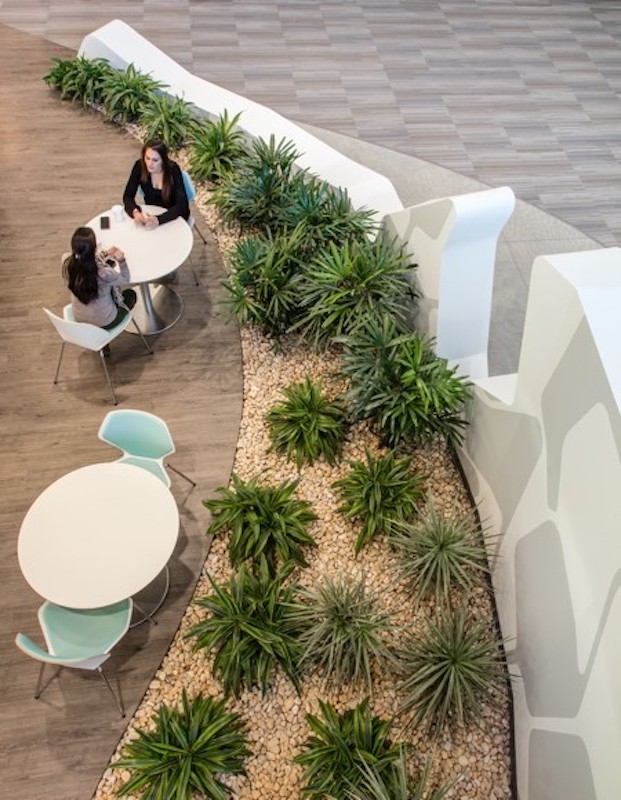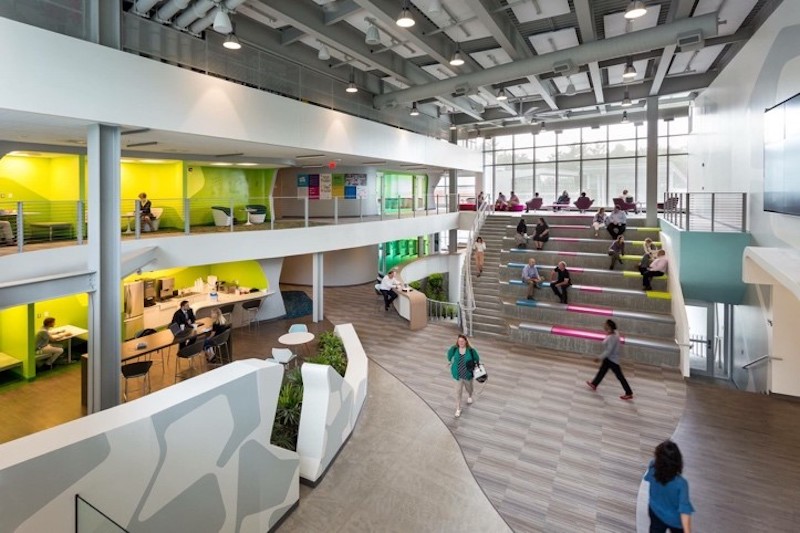An R&D building on the Billerica, Mass., campus of EMD Serono—a biopharmaceutical business of Merck KGaA, Darmstadt, Germany that focuses on specialty care—became the first in the United States to receive Gold-level certification for New and Existing Buildings from the International WELL Building Institute.
The Sagamore Building, as it is known, is part of a three-building, 275,000-sf campus with more than 500 employees who work to accelerate R&D innovation in oncology, immune-oncology, and immunology. The campus is one of four global R&D hubs for the company.The Sagamore Building, which was completed last year, has also earned LEED Platinum certification from the U.S. Green Building Council.
To achieve WELL certification, EMD Serono started with a two-day design charette that included architects, engineers, designers, and facilities managers who brainstormed, built models, and challenged notions of space. (The Building Team included Boston-based architect Ellenzwieg.)
To meet WELL’s building standard, the project—which included a new addition and a retrofit of an existing building—installed WELL-compliant lighting fixtures, and MERV 15 high efficiency air filters under ASHRAE 52.2/MERV. EMD Serono also changed to compliant cleaning chemicals and protocols, and increased its preventive maintenance schedules to quarterly, with photographic documentation of service.

EMD Serono's Sagamore Building offers its employees a variety of healthier spaces in which to work and collaborative. Image: EMD Serono
Employees now have a variety of work environments to choose from, including open spaces, huddle rooms, and designated technology-free quiet zones. WELL also requires stairs between floors to encourage exercise and occupant movement. The design of the Sagamore building’s bleacher seating and auditorium was conceived during the design phase. The seating’s construction involved rebar and build forms that were supported with special staging for several concrete pours.
The Sagamore Building underwent testing and a final evaluation by Green Business Certification Inc. (GBCI), WELL’s third-party certification entity, which corroborated that the built environment was designed to improve occupants’ nutrition, fitness, mood, sleep patterns and performance.
Anthony Meenaghan, EMD Serono’s Senior Director, Facilities Management and Engineering, Environmental Health & Safety, says the WELL certification highlights his company’s collaborative and knowledge-sharing culture. “Offering employees an environment where they can do their best work plays an important role in bringing meaningful solutions to people with difficult-to-treat diseases.”
Related Stories
Sustainability | May 11, 2023
Let's build toward a circular economy
Eric Corey Freed, Director of Sustainability, CannonDesign, discusses the values of well-designed, regenerative buildings.
BIM and Information Technology | May 8, 2023
3 ways computational tools empower better decision-making
NBBJ explores three opportunities for the use of computational tools in urban planning projects.
Mass Timber | May 1, 2023
SOM designs mass timber climate solutions center on Governors Island, anchored by Stony Brook University
Governors Island in New York Harbor will be home to a new climate-solutions center called The New York Climate Exchange. Designed by Skidmore, Owings & Merrill (SOM), The Exchange will develop and deploy solutions to the global climate crisis while also acting as a regional hub for the green economy. New York’s Stony Brook University will serve as the center’s anchor institution.
University Buildings | Apr 24, 2023
Solving complicated research questions in interdisciplinary facilities
University and life science project owners should consider the value of more collaborative building methods, close collaboration with end users, and the benefits of partners who can leverage sector-specific knowledge to their advantage.
Laboratories | Mar 9, 2023
5 laboratory design choices that accelerate scientific discovery
Stephen Blair, director of CannonDesign's Science & Technology Practice, identifies five important design strategies to make the most out of our research laboratories.
University Buildings | Feb 9, 2023
3 ways building design can elevate bold thinking and entrepreneurial cultures
Mehrdad Yazdani of CannonDesign shares how the visionary design of a University of Utah building can be applied to other building types.
Giants 400 | Feb 9, 2023
New Giants 400 download: Get the complete at-a-glance 2022 Giants 400 rankings in Excel
See how your architecture, engineering, or construction firm stacks up against the nation's AEC Giants. For more than 45 years, the editors of Building Design+Construction have surveyed the largest AEC firms in the U.S./Canada to create the annual Giants 400 report. This year, a record 519 firms participated in the Giants 400 report. The final report includes 137 rankings across 25 building sectors and specialty categories.
University Buildings | Feb 7, 2023
Kansas City University's Center for Medical Education Innovation can adapt to changes in medical curriculum
The Center for Medical Education Innovation (CMEI) at Kansas City University was designed to adapt to changes in medical curriculum and pedagogy. The project program supported the mission of training leaders in osteopathic medicine with a state-of-the-art facility that leverages active-learning and simulation-based training.
Mass Timber | Jan 30, 2023
Net-positive, mass timber building will promote research on planetary well-being in Barcelona
ZGF Architects, along with Barcelona-based firms MIRAG and Double Twist, have designed a net-positive, mass timber center for research on planetary well-being. Located in Barcelona, the Mercat del Peix Research Center will bring together global experts in the experimental sciences, social sciences, and humanities to address challenges related to the future of the planet.
Adaptive Reuse | Dec 21, 2022
University of Pittsburgh reinvents century-old Model-T building as a life sciences research facility
After opening earlier this year, The Assembly recently achieved LEED Gold certification, aligning with the school’s and community’s larger sustainability efforts.

















